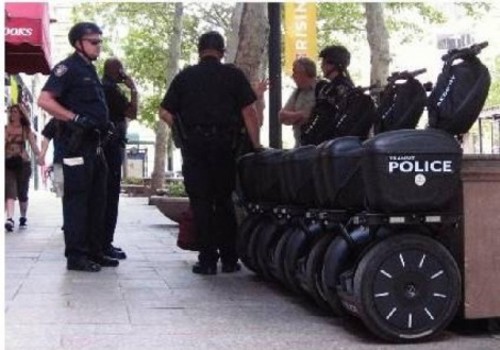UTA steps up TRAX security
New Segways used to help officers catch more jaywalkers, smokers and riders who don't pay.
By Jesse FruhwirthWatch your toes the next time you’re on a crowded TRAX platform. Jaywalkers, smokers, and free riders, in particular, will want to watch out for the rolling wheels of police officers´ Segways.
At a total cost of $47,600 for six units, the Segways are being used primarily around downtown Salt Lake City platforms by Utah Transit Authority officers, says UTA spokesman Gerry Carpenter. Six of the two-wheel scooters were purchased for the 35-officer agency with stimulus money, one percent of which had to be used for security equipment.
The officers are focusing primarily on offenses such as jaywalking, smoking on platforms and riding without a ticket.
“One of the real advantages of them is the height advantage,” Carpenter says. “Because of the elevated height, [officers] are able to see some kind of criminal activity in progress and address it. … The whole idea is to be able to move around.”
The Segways also will be used for travel between stations. For example, officers at the Intermodal Hub on 600 West who receive a call about a disturbance on a Main Street platform could go to the station on the Segways. The advantage over a car in that case, Carpenter says, is the officer won’t have to find a parking spot or obstruct traffic upon arrival.
Frequent UTA critic and advocate for riders with disabilities Barbara Toomer snickered when told about the purchase.
“To buy six of them to roam up and down Main Street ... I mean, come on, guys,” Toomer says.
Always goading UTA to expand its compliance with the Americans with Disabilities Act, Toomer suggested UTA should have purchased a vehicle that would allow individuals with disabilities to work as UTA police officers.
“Why not hire [people with disabilities] to be police officers?” asks Toomer, who uses a wheelchair. “I can stop people from smoking.”
The scooters do have disadvantages over bikes, cars or feet. Quickly crossing busy downtown intersections might be slower without a squad car equipped with lights and sirens. Moving in some ways that are easy on foot—like stairs or even hopping up or down a curb—are difficult and discouraged on UTA’s Segways.
“We don’t consider them pursuit vehicles, like a bike or a car,” Carpenter says. While the vehicles can go up and down curbs, officers are trained to avoid that, when possible. “If there is a ramp, we prefer they use the ramp instead.”
Thus, a quick jaywalker pursued by a UTA police officer on a Segway may be able to jump on the train to evade the officer. “They are not going to abandon [the Segways], although they can take the key if they need to do a pursuit on foot,” Carpenter says.
UTA is the second police force to have purchased scooters. In December, the Salt Lake City Police Department purchased a handful of T3 Motion electric vehicles. At nearly $9,000 each, those vehicles were purchased as a part of the department’s experiment with energy-efficient vehicles, spokeswoman Lara Jones says, and they may or may not find a permanent home in the department’s garage.
“They’ve been really helpful on the Jordan River Parkway, because they’re quiet,” Jones says. The scooter´s stealth is especially useful because the parkway is notorious for homeless tent communities and men cruising for public sex.
Toomer, the board secretary for the Disabled Rights Action Committee, recently chastised UTA for planning to eliminate unlimited monthly passes for paratransit services and curtailing curbside services. Those plans have since been revised. The monthly passes will stay and a new system for curbside pickup is being formulated.
UTA is partially funded by sales tax, the revenues of which have dropped during the recession.
UTA received $48.3 million from the Federal Transit Administration as a result of the American Recovery and Reinvestment Act. Of that, $24.8 million may go toward a new light rail service center along the Jordan River Parkway in South Salt Lake, which is now Workman Park. Other funds will go toward fencing around TRAX lines and security cameras.
Six Segways are plenty, Carpenter said, and there are no plans to buy more. Besides occasional big events like the Hill Air Force Base air show and patrolling some park-andride lots, Carpenter says Main Street will be their primary area of use.
More by Jesse Fruhwirth
-
Johnny's Rotten
Johnny Bangerter wants to move forward as an activist but just can't shake his racist punk past
- Apr 10, 2013
-
Right of Way
Eviction of Occupy SLC is a loss for community
- Nov 23, 2011
-
The Limbo Party
Redistricting: How low can Utah Dems go?
- May 19, 2011
- More »
Latest in News
Readers also liked…
-
Raise a glass for E.L.T Harrison, architect of the Beerhive building on Main
Small Lake City
- Oct 11, 2023




